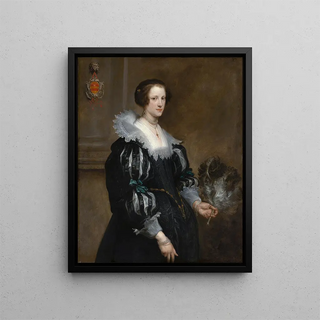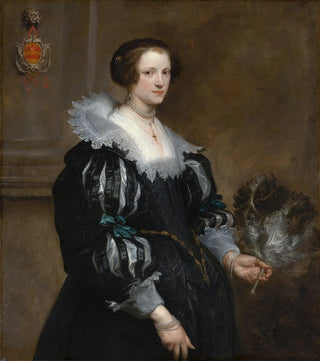Art print | Portrait of Anna Wake - Antoine van Dyck


View from behind

Frame (optional)
Portrait of Anna Wake - Antoine van Dyck – Captivating Introduction
The "Portrait of Anna Wake" by Antoine van Dyck is an iconic artwork that embodies the elegance and refinement of the 17th century. This painting, which captures the beauty and grace of its model, transports us to a time when art and nobility intertwined harmoniously. Anna Wake, wife of an English aristocrat, is depicted with a delicacy that highlights not only her social status but also the technical mastery of the artist. Through this art print, viewers are invited to immerse themselves in a universe where every detail, every brushstroke, tells a rich and fascinating story.
Style and uniqueness of the artwork
The uniqueness of this piece lies in how Van Dyck manages to combine realism and idealization. Anna Wake's face, delicately modeled, is illuminated by a soft light that accentuates her fine features and serene expression. The drapes of her dress, beautifully rendered, seem almost alive, demonstrating the artist's unparalleled talent for depicting textures. The chosen color palette, subtle and harmonious, evokes an atmosphere of calm and dignity. This portrait does not merely depict a woman; it immortalizes an essence, a presence that transcends time. Through this work, Van Dyck offers us a glimpse into the soul of his model, while revealing his own artistic vision.
The artist and his influence
Antoine van Dyck, a pupil of Rubens, developed a style that is uniquely his own, blending the richness of Flemish colors with Italian sensitivity. His influence on Baroque portraiture is undeniable, and he captured the spirit of his era while innovating in his way of representing human figures. Van Dyck succeeded in establishing a new standard for aristocratic portraiture, emphasizing not only the social status of his models but also their personality. His psychological approach to portraiture profoundly impacted his contemporaries and paved the way for many artists who followed. By immortalizing Anna Wake, he does not merely create an image; he forges a link between the past and the present, a legacy that continues to inspire generations of artists.

Matte finish

View from behind

Frame (optional)
Portrait of Anna Wake - Antoine van Dyck – Captivating Introduction
The "Portrait of Anna Wake" by Antoine van Dyck is an iconic artwork that embodies the elegance and refinement of the 17th century. This painting, which captures the beauty and grace of its model, transports us to a time when art and nobility intertwined harmoniously. Anna Wake, wife of an English aristocrat, is depicted with a delicacy that highlights not only her social status but also the technical mastery of the artist. Through this art print, viewers are invited to immerse themselves in a universe where every detail, every brushstroke, tells a rich and fascinating story.
Style and uniqueness of the artwork
The uniqueness of this piece lies in how Van Dyck manages to combine realism and idealization. Anna Wake's face, delicately modeled, is illuminated by a soft light that accentuates her fine features and serene expression. The drapes of her dress, beautifully rendered, seem almost alive, demonstrating the artist's unparalleled talent for depicting textures. The chosen color palette, subtle and harmonious, evokes an atmosphere of calm and dignity. This portrait does not merely depict a woman; it immortalizes an essence, a presence that transcends time. Through this work, Van Dyck offers us a glimpse into the soul of his model, while revealing his own artistic vision.
The artist and his influence
Antoine van Dyck, a pupil of Rubens, developed a style that is uniquely his own, blending the richness of Flemish colors with Italian sensitivity. His influence on Baroque portraiture is undeniable, and he captured the spirit of his era while innovating in his way of representing human figures. Van Dyck succeeded in establishing a new standard for aristocratic portraiture, emphasizing not only the social status of his models but also their personality. His psychological approach to portraiture profoundly impacted his contemporaries and paved the way for many artists who followed. By immortalizing Anna Wake, he does not merely create an image; he forges a link between the past and the present, a legacy that continues to inspire generations of artists.






